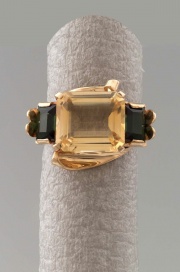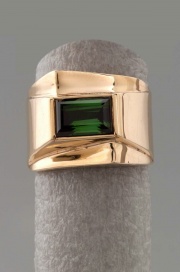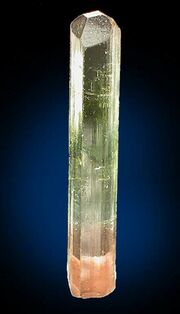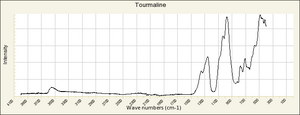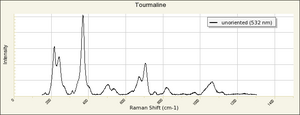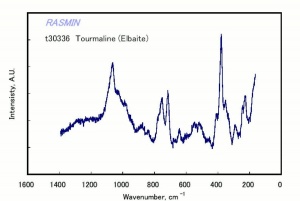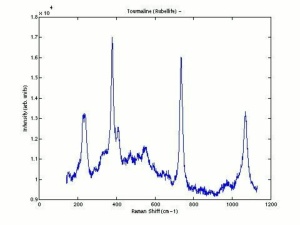Difference between revisions of "Tourmaline"
m (Text replace - "== Authority ==" to "== Sources Checked for Data in Record ==") |
|||
| (10 intermediate revisions by 2 users not shown) | |||
| Line 1: | Line 1: | ||
| − | [[File:2002.404-SC73200.jpg|thumb|]] | + | [[File:2002.404-SC73200.jpg|thumb|Tourmalines aside topaz<br>2002.404]] |
== Description == | == Description == | ||
| + | [[File:2002.405-SC73201.jpg|thumb|Green tourmaline ring<br>2002.404]] | ||
| + | A semiprecious [[gemstone|gemstone]] composed of an aluminum borosilicate mineral. Tourmaline occurs in pegmatite deposits, such as found in the Ural Mountains, Bohemia, Germany (Saxony), India, the island of Elba, Norway, England, Greenland, Brazil, Madagascar, and the U.S. (New England, New York, New Jersey, Pennsylvania, California). Tourmalines can be opaque or transparent and range in color from black, dark blue (indicolite), light blue (Brazilian sapphire), brown (dravite), green (Brazilian emerald), red (rubellite), red/green parti-colored (watermelon) and, though rare, colorless (achroite). Opaque black tourmalines, called schorl, are the most common. Tourmalines form [[static%20electricity|static electricity]] when they are rubbed or heated. This property makes them useful in pressure gauges, oscillator plates, and other electrical equipment. | ||
| + | [[File:tourmalinedw.jpg|thumb|Tourmaline (elbaite) crystal]] | ||
| − | |||
| − | |||
| − | |||
== Synonyms and Related Terms == | == Synonyms and Related Terms == | ||
| + | schorl (opaque black); tourmalin; turmaline; elbaite; indicolite (blue); rubellite (pink or red); dravite (brown); achroite (colorless); Brazilian sapphire (light blue); Brazilian emerald (green); Turmalin (Deut, Pol.); turmalina (Esp., Port.); tourmaline (Fr.); toermalijn (Ned.) | ||
| + | [[[SliderGallery rightalign|Tourmaline IR-ATR RRUFF R080010.png~IR-ATR (RRUFF)|Tourmaline Raman RRUFF R080010.png~Raman (RRUFF)|tourmalineRS.jpg~Raman (RASMIN)|TourmalineRubelliteitaly2.jpg~Raman (U of Parma)]]] | ||
| + | == Risks == | ||
| + | * Tourmaline is piezoelectric (develops a charge when heated) and may attract dust when displayed under a hot light. | ||
| + | == Physical and Chemical Properties == | ||
| − | + | * Trigonal system with small, often rounded, hexagonal crystalline prisms, plates or wedges | |
| − | + | * Cleavage = indistinct | |
| − | + | * Fracture = conchoidal to uneven | |
| − | + | * Luster = vitreous to resinous | |
| − | + | * Streak = white | |
| − | + | * Fluorescence = variable; some pink stones may show weak red in LW and SW | |
| − | + | * Pleochroism = dichroic: medium to strong; usually two tones of gem color | |
| − | + | * Inclusions = thread-like liquid and gas inclusions; mirror-like gas-filled fractures | |
| − | |||
| − | |||
| − | Luster = vitreous to resinous | ||
{| class="wikitable" | {| class="wikitable" | ||
| Line 28: | Line 30: | ||
|- | |- | ||
! scope="row"| Density | ! scope="row"| Density | ||
| − | | 2.9-3.2 | + | | 2.9-3.2 g/ml |
|- | |- | ||
! scope="row"| Refractive Index | ! scope="row"| Refractive Index | ||
| − | | 1. | + | | 1.624 - 1.650 |
| + | |- | ||
| + | ! scope="row"| Birefringence | ||
| + | | 0.018 - 0.020 | ||
| + | |- | ||
| + | ! scope="row"| Dispersion | ||
| + | | 0.017 | ||
|} | |} | ||
| − | |||
| − | |||
| − | |||
| − | |||
== Comparisons == | == Comparisons == | ||
| Line 44: | Line 48: | ||
[[media:download_file_444.pdf|Natural and Simulated Diamonds]] | [[media:download_file_444.pdf|Natural and Simulated Diamonds]] | ||
| − | + | ==Resources and Citations== | |
| − | + | * Gem Identification Lab Manual, Gemological Institute of America, 2016. | |
| − | == | ||
| − | |||
| − | |||
| − | |||
| − | |||
| − | |||
| − | |||
| − | |||
| − | |||
* Jack Odgen, ''Jewellery of the Ancient World'', Rizzoli International Publications Inc., New York City, 1982 | * Jack Odgen, ''Jewellery of the Ancient World'', Rizzoli International Publications Inc., New York City, 1982 | ||
| − | |||
* R.F.Symmes, T.T.Harding, Paul Taylor, ''Rocks, Fossils and Gems'', DK Publishing, Inc., New York City, 1997 | * R.F.Symmes, T.T.Harding, Paul Taylor, ''Rocks, Fossils and Gems'', DK Publishing, Inc., New York City, 1997 | ||
| − | + | * ''Encyclopedia Britannica'', http://www.britannica.com Comment: "tourmaline" [Accessed December 4, 2001]. (tech info).. | |
| − | * ''Encyclopedia Britannica'', http://www.britannica.com Comment: "tourmaline" | + | * Website: http://www.geo.utexas.edu/courses/347k/redesign/gem_notes/Tourmaline/tourm_triple_page.htm |
| − | |||
| − | * Website | ||
| − | |||
* C.W.Chesterman, K.E.Lowe, ''Audubon Society Field Guide to North American Rocks and Minerals'', Alfred A. Knopf, New York, 1979 | * C.W.Chesterman, K.E.Lowe, ''Audubon Society Field Guide to North American Rocks and Minerals'', Alfred A. Knopf, New York, 1979 | ||
| − | + | * Wikipedia: [https://en.wikipedia.org/wiki/Tourmaline Tourmaline] (Accessed Sept. 17, 2005 and Dec 2022) | |
| − | * Wikipedia | ||
| − | |||
* G.S.Brady, ''Materials Handbook'', McGraw-Hill Book Co., New York, 1971 Comment: p. 435 | * G.S.Brady, ''Materials Handbook'', McGraw-Hill Book Co., New York, 1971 Comment: p. 435 | ||
| − | |||
* Richard S. Lewis, ''Hawley's Condensed Chemical Dictionary'', Van Nostrand Reinhold, New York, 10th ed., 1993 | * Richard S. Lewis, ''Hawley's Condensed Chemical Dictionary'', Van Nostrand Reinhold, New York, 10th ed., 1993 | ||
| − | |||
* ''Van Nostrand's Scientific Encyclopedia'', Douglas M. Considine (ed.), Van Nostrand Reinhold, New York, 1976 | * ''Van Nostrand's Scientific Encyclopedia'', Douglas M. Considine (ed.), Van Nostrand Reinhold, New York, 1976 | ||
| − | |||
* Random House, ''Webster's Encyclopedic Unabridged Dictionary of the English Language'', Grammercy Book, New York, 1997 | * Random House, ''Webster's Encyclopedic Unabridged Dictionary of the English Language'', Grammercy Book, New York, 1997 | ||
| − | |||
* ''The American Heritage Dictionary'' or ''Encarta'', via Microsoft Bookshelf 98, Microsoft Corp., 1998 | * ''The American Heritage Dictionary'' or ''Encarta'', via Microsoft Bookshelf 98, Microsoft Corp., 1998 | ||
| − | |||
* ''CRC Handbook of Chemistry and Physics'', Robert Weast (ed.), CRC Press, Boca Raton, Florida, v. 61, 1980 Comment: density=3.0-3.2 | * ''CRC Handbook of Chemistry and Physics'', Robert Weast (ed.), CRC Press, Boca Raton, Florida, v. 61, 1980 Comment: density=3.0-3.2 | ||
| − | |||
[[Category:Materials database]] | [[Category:Materials database]] | ||
Latest revision as of 12:27, 4 January 2023
Description
A semiprecious Gemstone composed of an aluminum borosilicate mineral. Tourmaline occurs in pegmatite deposits, such as found in the Ural Mountains, Bohemia, Germany (Saxony), India, the island of Elba, Norway, England, Greenland, Brazil, Madagascar, and the U.S. (New England, New York, New Jersey, Pennsylvania, California). Tourmalines can be opaque or transparent and range in color from black, dark blue (indicolite), light blue (Brazilian sapphire), brown (dravite), green (Brazilian emerald), red (rubellite), red/green parti-colored (watermelon) and, though rare, colorless (achroite). Opaque black tourmalines, called schorl, are the most common. Tourmalines form Static electricity when they are rubbed or heated. This property makes them useful in pressure gauges, oscillator plates, and other electrical equipment.
Synonyms and Related Terms
schorl (opaque black); tourmalin; turmaline; elbaite; indicolite (blue); rubellite (pink or red); dravite (brown); achroite (colorless); Brazilian sapphire (light blue); Brazilian emerald (green); Turmalin (Deut, Pol.); turmalina (Esp., Port.); tourmaline (Fr.); toermalijn (Ned.)
Risks
- Tourmaline is piezoelectric (develops a charge when heated) and may attract dust when displayed under a hot light.
Physical and Chemical Properties
- Trigonal system with small, often rounded, hexagonal crystalline prisms, plates or wedges
- Cleavage = indistinct
- Fracture = conchoidal to uneven
- Luster = vitreous to resinous
- Streak = white
- Fluorescence = variable; some pink stones may show weak red in LW and SW
- Pleochroism = dichroic: medium to strong; usually two tones of gem color
- Inclusions = thread-like liquid and gas inclusions; mirror-like gas-filled fractures
| Composition | (Na,Ca)(Al,Fe)B3Al3(AlSi2O9)(O,OH,F)4 |
|---|---|
| Mohs Hardness | 7.0 - 7.5 |
| Density | 2.9-3.2 g/ml |
| Refractive Index | 1.624 - 1.650 |
| Birefringence | 0.018 - 0.020 |
| Dispersion | 0.017 |
Comparisons
Properties of Common Gemstones
Natural and Simulated Diamonds
Resources and Citations
- Gem Identification Lab Manual, Gemological Institute of America, 2016.
- Jack Odgen, Jewellery of the Ancient World, Rizzoli International Publications Inc., New York City, 1982
- R.F.Symmes, T.T.Harding, Paul Taylor, Rocks, Fossils and Gems, DK Publishing, Inc., New York City, 1997
- Encyclopedia Britannica, http://www.britannica.com Comment: "tourmaline" [Accessed December 4, 2001]. (tech info)..
- Website: http://www.geo.utexas.edu/courses/347k/redesign/gem_notes/Tourmaline/tourm_triple_page.htm
- C.W.Chesterman, K.E.Lowe, Audubon Society Field Guide to North American Rocks and Minerals, Alfred A. Knopf, New York, 1979
- Wikipedia: Tourmaline (Accessed Sept. 17, 2005 and Dec 2022)
- G.S.Brady, Materials Handbook, McGraw-Hill Book Co., New York, 1971 Comment: p. 435
- Richard S. Lewis, Hawley's Condensed Chemical Dictionary, Van Nostrand Reinhold, New York, 10th ed., 1993
- Van Nostrand's Scientific Encyclopedia, Douglas M. Considine (ed.), Van Nostrand Reinhold, New York, 1976
- Random House, Webster's Encyclopedic Unabridged Dictionary of the English Language, Grammercy Book, New York, 1997
- The American Heritage Dictionary or Encarta, via Microsoft Bookshelf 98, Microsoft Corp., 1998
- CRC Handbook of Chemistry and Physics, Robert Weast (ed.), CRC Press, Boca Raton, Florida, v. 61, 1980 Comment: density=3.0-3.2
